Faustina Kowalska
Maria Faustyna Kowalska (born Helena Kowalska; 1905–1938[1]), also known as Saint Maria Faustyna Kowalska of the Blessed Sacrament and popularly spelled Faustina, was a Polish Roman Catholic nun and mystic. Her apparitions of Jesus Christ inspired the Roman Catholic devotion to the Divine Mercy and earned her the title of "Secretary of Divine Mercy".
Maria Faustina (Kowalska) of the Blessed Sacrament OLM | |
|---|---|
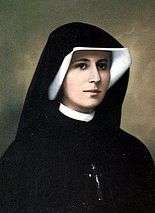 | |
| Virgin, Religious, Christian Mystic, "Apostle of Divine Mercy" | |
| Born | 25 August 1905 Głogowiec, Łęczyca County, Congress Poland, Russian Empire |
| Died | 5 October 1938 (aged 33) Kraków, Second Polish Republic |
| Venerated in | Roman Catholic Church |
| Beatified | 18 April 1993, St. Peter's Square, Vatican City by Pope John Paul II |
| Canonized | 30 April 2000, St. Peter's Square, Vatican City by Pope John Paul II |
| Major shrine | Basilica of Divine Mercy, Kraków, Poland |
| Feast | 5 October |
| Part of a series on the |
| Divine Mercy |
|---|
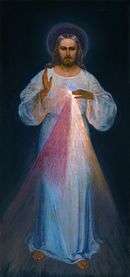 The image by Kazimirowski |
| Forms |
|
| People |
|
| Places |
|
| Other |
|
Throughout her life, Kowalska reported having visions of Jesus and conversations with him, of which she wrote in her diary, later published as The Diary of Saint Maria Faustina Kowalska: Divine Mercy in My Soul. Her biography, submitted to the Congregation for the Causes of Saints, quoted some of these conversations with Jesus regarding the Divine Mercy devotion.[2]
At the age of 20 years, she joined a convent in Warsaw, was transferred to Płock, and was later moved to Vilnius where she met her confessor Father Michał Sopoćko, who supported her devotion to the Divine Mercy. Kowalska and Sopoćko directed an artist to paint the first Divine Mercy image, based on Kowalska's vision of Jesus. Sopoćko used the image in celebrating the first Mass on the first Sunday after Easter. Subsequently, Pope John Paul II established the Feast of Divine Mercy on that Sunday of each liturgical year.
The Roman Catholic Church canonized Kowalska as a saint on 30 April 2000.[3][4] The mystic is classified in the liturgy as a virgin[5] and is venerated within the church as the "Apostle of Divine Mercy". Her tomb is in Divine Mercy Sanctuary, Kraków-Łagiewniki, where she spent the end of her life and met confessor Józef Andrasz who also supported the message of mercy.
Childhood and early years
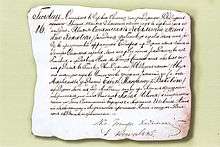
She was born as Helena Kowalska on 25 August 1905 in Głogowiec, Łęczyca County, north-west of Łódź in Poland. She was the third of ten children of Stanisław Kowalski and Marianna Kowalska. Her father was a carpenter and a peasant, and the family was poor and religious.[6]
She stated that she first felt a calling to the religious life while attending the Exposition of the Blessed Sacrament at 7 years of age.[7] She wanted to enter the convent after completing her time at school, but her parents would not give her permission. When she was 16 years old, she went to work as a housekeeper, first in Aleksandrów Łódzki where she received the Sacrament of Confirmation, then in Łódź, to support herself and to help her parents.[2]
Joining the convent in Warsaw
| Part of a series on | |||||||||||||||||||||||||||||
| Christian mysticism | |||||||||||||||||||||||||||||
|---|---|---|---|---|---|---|---|---|---|---|---|---|---|---|---|---|---|---|---|---|---|---|---|---|---|---|---|---|---|
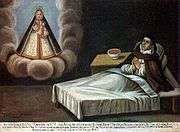 | |||||||||||||||||||||||||||||
|
Theology · Philosophy
|
|||||||||||||||||||||||||||||
|
Practices
|
|||||||||||||||||||||||||||||
|
People (by era or century)
|
|||||||||||||||||||||||||||||
|
Literature · Media
|
|||||||||||||||||||||||||||||
In 1924, at the age of 19 years, Kowalska went with her sister Natalia to a dance in a park in Łódź. Kowalska said that, while at the dance, she had a vision of a suffering Jesus. She then went to the cathedral. From there, she said Jesus instructed her to depart for Warsaw immediately and to join a convent.[8] She took a train for Warsaw (around 85 miles away) without gaining the permission of her parents, knowing anyone in Warsaw, or bringing any belongings other than the dress she was wearing.[9] After she arrived, she entered the first church she saw (Saint James Church in the Ochota district) and attended Mass. She asked the priest, Father Dąbrowski, for suggestions, and he recommended staying with a Mrs. Lipszycowa, a local woman whom he considered trustworthy, until she found a convent.
Kowalska approached several convents in Warsaw, but was turned down every time, in one case being told that "we do not accept maids here", referring to her poverty. Kowalska could read and write and had three or four years of education. After several weeks of searching, the mother superior at the convent of Zgromadzenie Sióstr Matki Bożej Miłosierdzia (Congregation of the Sisters of Our Lady of Mercy) decided to give Kowalska a chance and conditionally accepted her, provided that she could pay for her religious habit. Kowalska knew nothing of the convent she was entering except that she believed she was led there.
In 1925, Kowalska worked as a housemaid to save money, making deposits at the Convent throughout the year, and finally gained acceptance. On 30 April 1926, at the age of 20 years, she received her habit and took the religious name of Sister Maria Faustina of the Blessed Sacrament.[4] The name "Faustina" is a diminutive of Fausta, which means "fortunate" or "lucky".[10] Richard Torreto sees it as the feminine form of the name of a Roman martyr Faustinus, killed in AD 120.[11] Faustinus and Jovita. The Roman Martyrology lists a Saint Faustina of about AD 580 and two ancient saints (as well as four modern ones) called Faustinus, assigning the Roman martyr to the third or fourth century, while the other is the Faustinus associated with Jovita.[12] In April 1928, she took her first religious vows as a nun with her parents attending the profession rite.[4] She was a nun for a little more than a decade, and she died at the age of 33 years on 5 October 1938.
From February to April 1929, she was sent to the convent in Wilno, then in Poland, now Vilnius, Lithuania, as a cook. Although her time in that city was short, she returned there later and met Father Michael Sopoćko, who supported her mission. A year after her first return from Vilnius, in May 1930, she was transferred to the convent in Płock, Poland, for almost two years.[4]
Life as a nun
Płock and the image of Divine Mercy
Kowalska arrived in Płock in May 1930. That year, the first signs of her illness (which was later thought to be tuberculosis) appeared, and she was sent to rest for several months in a nearby farm owned by her religious order. After recovery, she returned to the convent, and by February 1931, she had been in the Płock area for about nine months.[4]
Kowalska wrote that on the night of Sunday, 22 February 1931, while she was in her cell in Płock, Jesus appeared wearing a white garment with red and pale rays emanating from his heart.[13] In her diary (Notebook I, items 47 and 48), she wrote that Jesus told her:
Paint an image according to the pattern you see, with the signature: "Jesus, I trust in You" (in Polish: "Jezu, ufam Tobie"). I desire that this image be venerated, first in your chapel, and then throughout the world. I promise that the soul that will venerate this image will not perish.[14]
Not knowing how to paint, Kowalska approached some other nuns at the convent in Płock for help, but she received no assistance.[15] Three years later, after her assignment to Vilnius, the first artistic rendering of the image was performed under her direction.
In the same 22 February 1931 message about the Divine Mercy image, Kowalska also wrote in her diary (Notebook I, item 49) that Jesus told her that he wanted the Divine Mercy image to be "solemnly blessed on the first Sunday after Easter; that Sunday is to be the Feast of Mercy."[16]
In November 1932, Kowalska returned to Warsaw to prepare to take her final vows as a nun. On 1 May 1933, she took her final vows in Łagiewniki and became a perpetual sister of Our Lady of Mercy.[4]
Vilnius and meeting Sopoćko
| Part of a series on the |
| Sacred Heart of Jesus |
|---|
 |
|
| Devotions |
|
| People |
|
| Encyclicals |
|
| Churches |
|
|
|
In late May 1933, Kowalska was transferred to Vilnius to work as the gardener, completing tasks including growing vegetables. She remained in Vilnius for about three years until March 1936. The convent in Vilnius had only 18 sisters at the time and consisted of a few scattered small houses rather than a large building.[17]
Shortly after arriving in Vilnius, Kowalska met Father Michael Sopoćko, the newly appointed confessor to the nuns. Sopoćko was also a professor of pastoral theology at Stefan Batory University (now called Vilnius University).
When Kowalska went to Sopoćko for her first confession, she told him that she had been conversing with Jesus, who had a plan for her.[17] After some time, in 1933 Sopoćko insisted on a complete psychiatric evaluation of Kowalska by Helena Maciejewska, a psychiatrist and a physician associated with the convent. Kowalska passed the required tests and was declared of sound mind.[18][19]
Thereafter, Sopoćko began to have confidence in Kowalska and supported her efforts. Sopoćko also advised Kowalska to begin writing a diary and to record the conversations and messages from Jesus that she was reporting.[17] Kowalska told Sopoćko about the Divine Mercy image, and in January 1934, Sopoćko introduced her to the artist Eugene Kazimierowski who was also a professor at the university.[20]
By June 1934, Kazimierowski had finished painting the image based on the direction of Kowalska and Sopoćko.[21] That was the only Divine Mercy painting Kowalska saw.[22] A superimposition of the face of Jesus in the Image of the Divine Mercy upon that in the already well-known Shroud of Turin shows great similarity.[23]
Kowalska wrote in her diary (Notebook I item 414) that, on Good Friday, 19 April 1935, Jesus told her that he wanted the Divine Mercy image publicly honoured.[4] A week later, on 26 April 1935, Sopoćko delivered the first sermon ever on the Divine Mercy, and Kowalska attended the sermon.[21]
The first Mass during which the Divine Mercy image was displayed occurred on 28 April 1935, the first Sunday after Easter Sunday, and was attended by Kowalska. This day was also the celebration of the end of the Jubilee of the Redemption by Pope Pius XI. Sopoćko obtained Archbishop Jałbrzykowski's permission to place the Divine Mercy image within the Gate of Dawn church in Vilnius during the Mass that Sunday and celebrated the Mass himself.[24]
On 13 September 1935, while still in Vilnius, Kowalska wrote of a vision about the Chaplet of Divine Mercy in her diary (Notebook I item 476).[25] The chaplet is about a third of the length of the Rosary.[26] Kowalska wrote that the purpose for chaplet's prayers for mercy are threefold: to obtain mercy, to trust in Christ's mercy, and to show mercy to others.[27]
In November 1935, Kowalska wrote the rules for a new contemplative religious congregation devoted to the Divine Mercy. In December, she visited a house in Vilnius which she said she had seen in a vision as the first convent for the congregation.[4]
In January 1936, Kowalska went to see Jałbrzykowski to discuss a new congregation for Divine Mercy. However, he reminded her that she was perpetually vowed to her current order.[28] In March 1936, Kowalska told her superiors that she was thinking of leaving the order to start a new one specifically devoted to Divine Mercy, but she was transferred to Walendów, southwest of Warsaw.[4] She reported that Jesus had said to her: "My Daughter, do whatever is within your power to spread devotion to My Divine Mercy, I will make up for what you lack."[29]
Kraków and Kowalska's final years
In 1936, Sopoćko wrote the first brochure on the Divine Mercy devotion, and Archbishop Jałbrzykowski provided his imprimatur for it. The brochure carried the Divine Mercy image on the cover. Sopoćko sent copies of the brochure to Kowalska in Warsaw.[30]
Later in 1936, Faustina became ill, since speculated to be tuberculosis. She was moved to the sanatorium in Prądnik, Kraków. She continued to spend much time in prayer, reciting the chaplet and praying for the conversion of sinners. The last two years of her life were spent praying and keeping her diary.[31][32]
On 23 March 1937, Kowalska wrote in her diary (Notebook III, item 1044) that she had a vision that the feast of the Divine Mercy would be celebrated in her local chapel and would be attended by large crowds and also that the same celebration would be held in Rome attended by the Pope.[20]
In July 1937 the first holy cards with the Divine Mercy image were printed. In August, Sopoćko asked Kowalska to write the instructions for the Novena of Divine Mercy, which she had reported as a message from Jesus on Good Friday 1937.[21]
Throughout 1937, progress was made in promoting the Divine Mercy, and in November 1937, a pamphlet was published with the title Christ, King of Mercy. The pamphlet included the chaplet, the novena, and the litany of the Divine Mercy. The Divine Mercy image appeared on the cover, with the signature, "Jesus I Trust in You". On 10 November 1937, Mother Irene, Kowalska's superior, showed her the booklets while Kowalska rested in her bed.[33]
As her health deteriorated at the end of 1937, Kowalska's reported visions intensified, and she was said to be looking forward to an end to her life.[21] In April 1938, her illness had progressed, and she was sent to rest in the sanatorium in Prądnik for what was to be her final stay there.[33]
In September 1938, Sopoćko visited her at the sanatorium and found her very ill but in ecstasy as she was praying. Later in the month, she was taken back home to Kraków to await her death there. Sopoćko visited her at the convent for the last time on 26 September 1938.[21]
Kowalska died at the age of 33 on 5 October 1938 in Kraków. She was buried on 7 October and now rests at Kraków's Basilica of Divine Mercy.[34]
Devotion to Divine Mercy
Spread of the Devotion
Before her death Kowalska predicted that "there will be a war, a terrible, terrible war" and asked the nuns to pray for Poland. In 1939, a year after Kowalska's death when Jałbrzykowski noticed that her predictions about the war had taken place, he allowed public access to the Divine Mercy image which resulted in large crowds that led to the spread of the Divine Mercy devotion.[35] The Divine Mercy devotion became a source of strength and inspiration for many people in Poland. By 1941 the devotion had reached the United States and millions of copies of Divine Mercy prayer cards were printed and distributed worldwide.[33]
In 1942 Jałbrzykowski was arrested by the Nazis, and Sopoćko and other professors went into hiding near Vilnius for about two years. During that period Sopoćko used his time to prepare for establishment of a new religious congregation based on the Divine Mercy messages reported by Kowalska. After the war, Sopoćko wrote the constitution for the congregation and helped the formation of what is now the Congregation of the Sisters of the Divine Mercy.[36] By 1951, 13 years after Kowalska's death, there were 150 Divine Mercy centers in Poland.[35][37]
On 24 June 1956, Pope Pius XII blessed an Image of the Divine Mercy in Rome, the only one blessed by a Pope before the Second Vatican Council.[38] In 1955, under Pope Pius XII, the Bishop of Gorzów founded a religious order called the Congregation of the Most Holy Lord Jesus Christ, Merciful Redeemer, to spread devotion to the Divine Mercy.[39][40] Under both Pope Pius XI and Pope Pius XII, writings on devotion to the Divine Mercy were given imprimaturs by many bishops, making it an approved devotion.[41][42][43][44] Cardinals Adam Stefan Sapieha and August Hlond were among those who gave their approval.[45][46] During the papacy of Pope Pius XII, Vatican Radio broadcast several times about the Divine Mercy.[47]
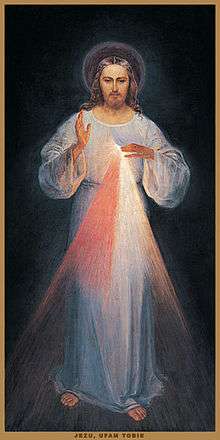
After a failed attempt to persuade Pope Pius XII to sign a condemnation, Cardinal Alfredo Ottaviani at the Holy Office included her works on a list he submitted to the newly elected Pope John XXIII in 1959.[48][49][50][51] On 6 March 1959, the Holy Office issued a notification, signed by Monsignor Hugh O'Flaherty as notary, that forbade circulation of "images and writings that promote devotion to Divine Mercy in the forms proposed by Sister Faustina" (emphasis in the original).[52] The negative judgment of the Holy Office was based both on a faulty French[53] or Italian[45][54][55][56][57] translation of the diary, and on theological difficulties such as the claim that Jesus had promised complete remission of sin for certain devotional acts without specifying whether the forgiveness would be obtained directly or through undertaking reception of the sacraments, and what may have been thought to be excessive concentration on Faustina herself.[54]
The ban remained in place for almost two decades. Meanwhile, Archbishop Karol Wojtyła of Kraków began in 1965, with the approval of the head of the Holy Office, the informative process on Kowalska's life and virtues,[53][54][54][58][59] Then, on 15 April 1978, the Congregation for the Doctrine of the Faith issued a new notification, signed by the Prefect and the Secretary of the Congregation, that rescinded the previous one, reversing the ban on circulation of Kowalska's work. It decreed: "This Sacred Congregation, in view of the many original documents that were unknown in 1959, giving consideration to the profoundly changed circumstances, and taking into account the view of many Polish ordinaries, declares no longer binding the prohibitions contained in the cited 'notification'.".[60][61] "Also, the Prefect of the Sacred Congregation for the Doctrine of the Faith declared that, "with the new 'notification' ... there no longer exists, on the part of this Sacred Congregation, any impediment to the spreading of the devotion to The Divine Mercy."[61]
Archbishop Karol Wojtyła later became Pope John Paul II and beatified and canonized Kowalska. He died in April 2005 on the eve of Divine Mercy Sunday, was himself beatified by his successor, Pope Benedict XVI, on Divine Mercy Sunday, 1 May 2011, and was canonized by Pope Francis on Divine Mercy Sunday, 27 April 2014. Divine Mercy Sunday is celebrated on the Second Sunday of Easter (the Sunday after Easter Sunday).
Sainthood
In 1965, with the approval of the Holy Office, Karol Wojtyła, then Archbishop of Kraków and later Pope John Paul II, opened the initial informative process into Kowalska's life and virtues, interviewed witnesses and in 1967 submitted a number of documents about Kowalska to the Vatican, requesting the start of the official process of her beatification. This was begun in 1968, and concluded with her beatification on 18 April 1993.[35] Saint Faustina was beatified on 18 April 1993 and canonized on 30 April 2000.[3][4] Her feast day is 5 October.
The Holy See's Press Office biography provided on the occasion of her canonization quotes some of her reputed conversations with Jesus.[2] The author and priest Benedict Groeschel considers a modest estimate of the following of the Divine Mercy devotion in 2010 to be over one hundred million Catholics.[62] Pope John Paul II said, "The message she brought is the appropriate and incisive answer that God wanted to offer to the questions and expectations of human beings in our time, marked by terrible tragedies. Jesus said to Sr Faustina one day: 'Humanity will never find peace until it turns with trust to the Divine Mercy.'"[63] In October 2011, a group of cardinals and bishops sent a petition to Pope Benedict XVI that Kowalska be made one of several female Doctors of the Church.[64]
Miracles
The formal beatification of Kowalska involved the case of Maureen Digan of Massachusetts.[65] In March 1981 Digan reported a healing, while praying at the tomb of Kowalska.[33] Digan had suffered from Lymphedema (a disease which causes significant swelling due to fluid retention) for decades, and had undergone ten operations, including a leg amputation. Digan reported that while praying at Kowalska's tomb, she heard a voice saying "ask for my help and I will help you" and her constant pain stopped. After two days, Digan reported that her foot - which had previously been too large for her shoe due to her body's liquid retention, was healed.[66] Upon her return to the United States, five Boston area physicians stated that she was healed and the case was declared miraculous by the Vatican in 1992 based on the additional testimony of over 20 witnesses about her prior condition.[66]
Similarly, years later, Father Ronald P. Pytel experienced a complete healing of a heart condition that he had first noticed in his early childhood. The condition later escalated into cardiac failure in the priest's more advanced years.[67] During his recovery from a heart surgery in June 1995, he prayed the Chaplet of Divine Mercy every day and frequently read the Diary of Saint (then Blessed) Faustina.[67] Pytel celebrated a Mass on 5 October, Blessed Faustina's feast day, where parishioners in attendance, including a healing ministry, prayed over him. The priest eventually found that, starting on the night of the Mass, taking his heart medication caused him a new and unexpected chest pain that he had not experienced prior to the Mass. He consulted with Dr. Nicholas Fortuin, and to the physician's surprise, Pytel's heart was completely normal and healthy.[67] Dr. Valentin Fuster has since confirmed that total transformation and healing of Pytel's heart occurred rapidly to the point of "complete relief of symptoms" within three days of the Mass on 5 October 1995.[67]
Films
- Divine Mercy: Sa Buhay Ni Sister Faustina (Philippines, 1993)
- Faustina (1995)
- Love and Mercy: Faustina (Docudrama, 2019)
Quotes from Diary
- The soul will not attain sanctity if it does not keep watch over its tongue. (92)
- The soul will respond more faithfully to divine grace if it has a well-informed confessor to whom it can confide everything. (95)
- Jesus told me that I please Him best by meditating on His sorrowful Passion, and by such meditation much light falls upon my soul. He who wants to learn true humility should reflect upon the Passion of Jesus. (267)
- Souls, do not be afraid of God, but trust in Him, for He is good, and His mercy is everlasting. (908)
- Oh, how astonished I am that some people deceive themselves, saying: There is no eternity! (990)
- My Jesus, You know that from my earliest years I have wanted to become a great saint; that is to say, I have wanted to love You with a love so great that there would be no soul who has hitherto loved You so. (1372)
See also
- Visions of Jesus and Mary
- Divine Mercy
- Chaplet of the Divine Mercy
- Divine Mercy image
- Divine Mercy novena
- Divine Mercy Sanctuary (Kraków)
- Józef Jarzębowski
- Michał Sopoćko
- Józef Andrasz
- Saint Faustina, patron saint archive
References
- Alban Butler and Paul Burns, 2005, Butler's Lives of the Saints, Burns and Oats. ISBN 0-86012-383-9. p. 251.
- Vatican web site: Biography of Faustina Kowalska.
- Pope John Paul II, Homily for the Canonization of Sr Mary Faustina Kowalska, 30 April 2000.
- Odell, Catherine M. (1998). Faustina. The Apostle of Divine Mercy. Huntington, Indiana: Our Sunday Visitor Publishing. pp. 191-4. ISBN 978-08-7973-923-2.
- Martyrologium Romanum (Typis Vaticanis 2004) ISBN 9788820972103, p. 557
- Odell, Catherine M. (1998). p. 14.
- Guiley 2001, p. 106.
- Guiley 2001, pp. 106-107.
- The Diary of Saint Maria Faustina Kowalska: Divine Mercy In My Soul, Saint Faustina Kowalska, 2002, Marians of the Immaculate Conception (Notebook I, items 10 and 11).
- See Faustus (praenomen)
- Torretto 2010, p. 10.
- Martyrologium Romanum (Typis Vaticanis 2004) ISBN 9788820972103, p. 730
- Odell, Catherine M. (1998). pp. 63-64.
- Drake 2002, pp. 89-90.
- Odell, Catherine M. (1998). pp. 65-75.
- Odell, Catherine M. (1998). p. 66.
- Odell, Catherine M. (1998). pp. 82-95.
- Great Women of Faith by Sue Stanton, 2003. ISBN 978-0-8091-4123-4. p. 30.
- New Catholic encyclopedia: jubilee volume, the Wojtyła years by Berard L. Marthaler, Richard E.McCarron and Gregory F. LaNave 2000. ISBN 0-7876-4787-X. p. 528.
- Ann Ball, 2003, Encyclopedia of Catholic Devotions and Practices. ISBN 0-87973-910-X. pp. 174-175.
- Torretto 2010, p. 16.
- Torretto 2010, pp. 84-107.
- The Congregation Of Sisters Of Merciful Jesus. "Faustina - The Congregation Of Sisters Of Merciful Jesus (Faustynki)". Faustina-message.com. Retrieved 28 April 2014.
- Odell, Catherine M. (1998). pp. 102-103.
- Chaplet of Divine Mercy.
- Torretto 2010, pp. 69-79.
- EWTN on the Chaplet of Divine Mercy.
- Odell, Catherine M. (1998). pp. 103-119.
- The Diary of Saint Maria Faustina Kowalska: Divine Mercy In My Soul. Saint Faustina Kowalska, 2003, Marian Press. ISBN 1-59614-110-7 (Note 136).
- Odell, Catherine M. (1998). p. 119.
- Odell, Catherine M. (1998). pp. 123 et passim.
- John J. Cleary, 15 Days of Prayer With Saint Faustina Kowalska, New City Press, 2010. ISBN 978-1-56548350-7. p. 101.
- Drake 2002, pp. 85-95.
- Retracing the footsteps of Saint Mary Faustina Kowalska
- Odell, Catherine M. (1998). pp. 153-160.
- Vatican biography of Michael Sopocko.
- The Divine Mercy website of the Marian Fathers: "A Priest after My Own Heart".
- The Pallotine Fathers: "le Saint Père - PIE XII, a béni l'Icône de Jésus Miséricordieux, le 24 juin 1956 à Rome. Dès la bénédiction papale accordée, l'image est revenue en France. A notre connaissance, cette icône de Jésus Miséricordieux d'Osny, est l'unique icône au monde, bénie par le Saint Père avant le Concile Vatican II."
- The Diary of Saint Maria Faustina Kowalska: Divine Mercy In My Soul, Saint Faustina Kowalska, 2003, Marian Press. ISBN 1-59614-110-7 (Note 96). "Saint Faustina wrote that the Lord Jesus was demanding from her the founding of a new community, whose aim would be to pray for Divine Mercy for the world and to spread the devotion of The Divine Mercy… On August 2, 1955, the Ordinary of Gorzow… on the basis of special authorization, established the Congregation of the Most Holy Lord Jesus Christ, Merciful Redeemer, whose aim was to spread the cult of The Divine Mercy".
- This website gives information on the Congregation of the Sisters of Merciful Jesus foundation as an association in 1942 and as a congregation of diocesan right (originally under the name "Sisters of Jesus Christ the Merciful Redeemer") on 2 August 1955 and received papal approval on 13 May 2008. It also gives information on the more recent Community of the Brothers of Merciful Jesus and Institute of Divine Mercy.
- The Diary of Saint Maria Faustina Kowalska: Divine Mercy In My Soul, Saint Faustina Kowalska, 2003, Marian Press. ISBN 1-59614-110-7 (Note 136).
- "Probably Father Sopocko's pamphlet called Milosierdzie Boze (Studium teologiczne-praktyczne) [The Divine Mercy (A Theological - Practical Study)], published in Vilnius in 1936. Imprimatur was given by Bishop Romuald on June 30, 1936, No. R. 298/36 (A. SF.). The cover of the pamphlet showed a color copy of Eugene Kazimierowski's image painted in Vilnius."
- The Diary of Saint Maria Faustina Kowalska: Divine Mercy In My Soul, Saint Faustina Kowalska, 2003, Marian Press. ISBN 1-59614-110-7 (Note 208).
- "Reference is to the imprimatur of two publications: 1. An image of Jesus with the Chaplet to The Divine Mercy on the back, for which Fr. Sopocko obtained permission in Vilnius on Sept. 1, 1937 (No. R. 200/ 37); 2. A small pamphlet under the title Chrystus Krol Milosierdzia (Christ King of Mercy), which included the novena, the chaplet and the litany to The Divine Mercy. The imprimatur was granted by the Metropolitan Curia in Cracow (L. 671/37). Both were published by the J. Cebulski Publishing House, 22 Szewska St., Cracow."
- The Diary of Saint Maria Faustina Kowalska: Divine Mercy In My Soul, Saint Faustina Kowalska, 2003, Marian Press. ISBN 1-59614-110-7 (Note 89).
- "During this time, Fr. Sopocko also began working on a treatise De Misericordia Dei Deque Eiusdem Festo Instituendo about the concept of Divine Mercy and about the Feast in its honor. He was encouraged by Cardinal August Hlond even before the war to pursue this work at the time when Fr. Sopocko had presented the Cardinal with his research regarding the matter of Divine Mercy." http://www.faustina-message.com/index.htm.
- "Vatican Radio talks about Divine Mercy…in 1948!". Thedivinemercy.org. 19 October 2005. Retrieved 28 April 2014.
- Prayer, Aspiration and Contemplation by Fr. Vernard Poslusney, 1994. ISBN 0-8189-0300-7. p. 187.
- History Shows Popes Views on Mystics Differ by Daniel Klimek
- The Divine Mercy Chaplet Archived 9 December 2014 at the Wayback Machine
- Mary Faustina Kowalska Archived 4 March 2014 at the Wayback Machine
- "Acta Apostolicae Sedis LI (1959), p. 271" (PDF). Retrieved 28 April 2014.
- Odell, Catherine M. (1998). Faustina. Our Sunday Visitor. p. 157. ISBN 978-0-87973923-2.
- "John L. Allen Jr, "A saint despite Vatican reservations" (National Catholic Reporter, 30 August 2002)". Natcath.org. 30 August 2002. Retrieved 28 April 2014.
- Stackpole, Robert (24 September 2012). "'A Priest After My Own Heart' | The Divine Mercy Message from the Marians of the Immaculate Conception". Thedivinemercy.org. Retrieved 28 April 2014.
- "The Divine Mercy Message from the Marians of the Immaculate Conception". Thedivinemercy.org. Retrieved 28 April 2014.
- Egan, Harvey D. (1991). An Anthology of Christian Mysticism. Liturgical Press. pp. 563–564. ISBN 9780814660126.
- "…Cardinal Ottaviani gave instructions to the archbishop actively promoting the beatification of Sr. Faustina to hurry and interview the witnesses before they all died." (Saints of the Jubilee A.D. 2002, edited by Tim Drake, p. 95.)
- Odell (1998), p. 158
- Acta Apostolicae Sedis LXX (1978), p. 350.
- Diary: Divine Mercy in My Soul. The Diary of Saint Maria Faustina Kowalska, 2003. ISBN 1-59614-110-7 (Note 89).
- Am With You Always by Benedict Groeschel 2010. ISBN 978-1-58617-257-2. p. 548.
- Pope John Paul II, Divine Mercy Sunday Homily, 22 April 2001.
- Anita S. Bourdin, St. Faustina – Doctor of the Church?
- Judy Roberts, Legatus magazine, 1 May 2010.
- Odell, Catherine M. (1998). pp. 159-160.
- "Personal Testimony of Father Ronald P. Pytel Regarding Healing of Heart Disease".
Sources
- Drake, Tim (2002). Saints of the Jubilee. ISBN 978-1-4033-1009-5.CS1 maint: ref=harv (link)
- Guiley, Rosemary Ellen (2001). The Encyclopedia of Saints. Facts on File. ISBN 0-8160-4134-2.CS1 maint: ref=harv (link)
- Kowalska, Faustina. Diary: Divine Mercy in My Soul. The Diary of Saint Maria Faustina Kowalska, 2003. ISBN 1-59614-110-7
- Torretto, Richard (2010). A Divine Mercy Resource. ISBN 978-1-4502-3236-4.CS1 maint: ref=harv (link)
- Vatican biography of Faustina Kowalska
External links
| Wikimedia Commons has media related to Faustyna Kowalska. |
- Polish Divine Mercy Shrines
- The Congregation of the Sisters of Our Lady of Mercy (multilingual)
- The Chapel of Saint Faustina on-line transmissions (multilingual)
- Sanctuary of the Divine Mercy (multilingual)
- Devotional organizations